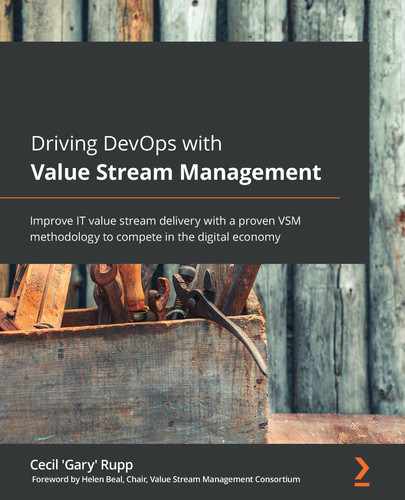Chapter 12: Introducing the Leading VSM Tool Vendors
In the previous chapter, you learned some of the essential capabilities of modern VSM tools. You also learned how to identify the three types of VSM tool classifications.
We also delved into the subject of common VSM tool implementation issues, the role VSM tools play in supporting digital business transformations, and their key benefits. Now we are going to move on to introduce the leading software tool vendors with industry-acknowledged VSM capabilities.
Rather than regurgitating what other industry analysts have written, I reached out to leading VSM tool, methodology, and service providers and asked them to tell us why their customers choose their products. Those vendors who chose to be interviewed for this book are listed in this chapter. In my interviews, I asked their designated representatives to explain what they believe their particular strengths are and why. They also had the opportunity to present one or two customer use cases they believed help showcase the strengths of their VSM tools and services.
In this chapter, we're going to cover the following topics:
- Putting modern VSM tools in perspective
- Improving value delivery
- Using VSM beyond CI/CD and DevOps
- Listing the leading VSM Tool Providers
We'll begin our journey through the leading VSM methods and tools with a word of caution.
Putting modern VSM tools in perspective
From the previous chapters, you now know that the concepts behind VSM are not new and have been applied to many industries and innumerable value streams. You also now know that VSM emerged from the discipline of Lean production improvements. Unlike traditional hierarchical and functional-centric views of making process improvements, Lean improvement structures organizational activities as orchestrated flows to deliver value optimally to internal and external customers.
Since VSM is fundamentally a strategy to help organizations marshal their resources to make Lean improvements, we spent some time in this book learning about Lean. And from that training, you now know that Lean is a system for planning and implementing continuous process improvements. The focus is on developing efficient production and information flows by eliminating all forms of waste from the customer's perspective. As a quick reminder, the common types of waste include defects, inventory, motion, overprocessing, overproduction, transportation, and waiting.
Improving value delivery
In Chapter 4, Defining Value Stream Management, you learned that James Martin articulated 17 common values streams. In his book The Great Transitions, Martin writes about the importance of defining and improving value stream flows as part of any business process redesign effort.
Martin built his concepts on Thomas Davenport's paper Process Innovation: Reengineering Work through Information Technology. In his paper, Davenport breaks down organizational value-adding processes into three categories:
- Product design, development, and manufacturing processes
- Customer-facing processes, including marketing and sales management, order management, and customer service
- Management and administrative processes
The important takeaway is that both Martin and Davenport evaluated process reengineering and process improvement initiatives through the lens of making value-based or value-delivery improvements, and with IT as a critical enabler of installing business process innovations. Furthermore, their writing explains why organizations cannot find real business process improvements by building processes and systems that maintain the status quo across hierarchical, bureaucratic, and functional domains. Put another way, Martin and Davenport advocated using IT to redesign business processes, but doing so from the perspective of adding value.
Based on what you've learned in this book, it should be apparent that VSM as a discipline has little to do with software tools, or even with making improvements to your organization's CI/CD and DevOps pipeline flows. VSM is much bigger and more important than that.
Using VSM beyond CI/CD and DevOps
Commercial companies, government agencies, and non-profits exist to deliver value in products, services, or other forms of desired results and outcomes. In our modern digital economy, Martin and Davenport's insights are more critical than ever. Improvements to our CI/CD and DevOps pipelines can improve our ability to deliver value across all organizational value streams.
But, of course, none of your CI/CD, DevOps, and VSM toolchain investments will amount to much if your IT organization is not synced up to support the organization's other value streams. Thus, it's essential to understand that your organization can expend much time, money, and effort on purchasing CI/CD, DevOps, and VSM tools and still fail to improve your value delivery capabilities.
CI/CD, DevOps, and VSM toolchain investments are examples of potential Kaizen Burst activities to enable other critical value stream improvements. Therefore, such investments are not inexpensive and become portfolio-level investment decisions supporting the organization's core business mission and strategy. However, CI/CD, DevOps, and VSM toolchain investments are foundational as they support any other VSM initiatives and must be evaluated in that light.
This concern is why so much space is devoted in this book to implementing a VSM initiative beyond the IT function. However, the primary driver for improving IT is to improve the other development and operations-oriented value streams they support. In other words, your IT-oriented Kaizen Bursts will be driven by other value stream improvement requirements. With this understanding, let's introduce the current tools and thought leaders in VSM.
Listing the leading VSM tool providers
This chapter introduces you to the leading VSM vendors, as identified by various industry analysts, such as Forrester Research, Gartner Inc., GIGAOM, SD Times, and others. However, I have purposely steered away from repeating the views of these other industry reports regarding specific product offerings.
Instead, my goal in this book was to identify the leaders and then let each VSM vendor tell their own story if they chose to do so. Their stories are found in the sections that follow. But, before we get to that section, we need first to learn who the perceived leaders are. So, Figure 12.1 shows the current list of VSM tool and methodology vendors, placed in alphabetical order:
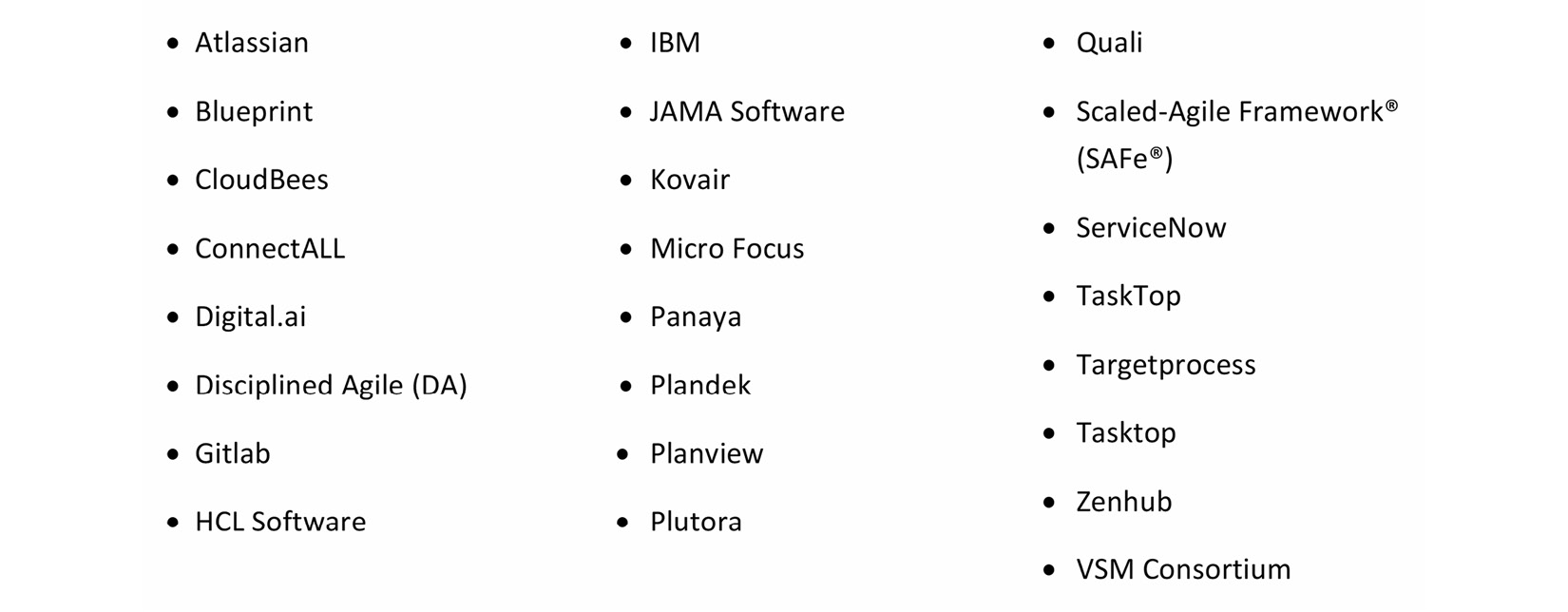
Figure 12.1 – List of Leading VSM Methods and Tools Vendors
I have added three VSM methodology companies, Disciplined Agile, SAFe, and the Value Stream Management Consortium (VSMC), which provide guidance on VSM applied to scaling Lean and Agile practices. However, the descriptions of their offerings are included in the next chapter, Chapter 13, Introducing the VSM-DevOps Practice Leaders.
As you read through the information on each listed VSM vendor, bear in mind how they support the improvements of CI/CD and DevOps pipelines from a Lean-oriented perspective. Also, recall that the three essential elements of a mature CI/CD or DevOps pipeline are integration, automation, and orchestration capabilities.
Finally, recall that VSM is a proven, effective, and disciplined step-by-step methodology for understanding and applying the principles and practices of Lean thinking. VSM as a discipline has been practiced for decades, applies across all organizational value streams, and has its roots in the Lean production concepts employed in the Toyota Production System (TPS).
The remainder of this section introduces the industry's current leading VSM tool vendors to summarize their capabilities. It's important to note that not all of these tools claim to have VSM support as a focus. For example, some DevOps and CI/CD tools vendors, such as Atlassian, have a vital role in software projects and product management. But we need to explore how their products might be employed in a VSM initiative.
Atlassian
Atlassian is an Australian team collaboration software tool company. Although Forrester Research includes Atlassian in their Forrester Wave™: Value Stream Management Solutions Scorecard (Q3 2020), Atlassian does not have a stated value stream management strategy. Nevertheless, Forrester gives the company high marks for its product vision, performance, partner ecosystem, and market presence.
When I asked Atlassian for a quote on their position relative to value stream management, I was told the following:
"While we don't sell a VSM solution specifically, our products are decisively used to span the development and operational value streams from concept to customer and back (learning loops). We believe in an open approach, so we integrate with just about everything, and we believe in being somewhat unopinionated so that our customers can design their optimal way of working."
With this information in mind, let's see how Atlassian fits into the VSM picture.
Two college friends, Mike Cannon-Brookes and Scott Farquhar, developed in 2002 what is arguably the number one project management software, Jira. Jira started as an issue tracking platform for software developers. However, in its current form, Jira Software helps Agile software development and support teams plan, track, and release their software.
Jira's capabilities to plan, track, and support project management are not limited to software development and IT operations activities. Organizations also use Jira to support collaborations across other value stream flows, such as product management, marketing, and sales. The objective is to support cross-team collaboration across all organizational value streams to coordinate product strategies, evolution, development, support, and sustainment activities.
Atlassian has grown in size and products over its nearly two decades of existence and currently offers 13 product offerings, spanning the following 4 solution areas:
- Plan, track, and support
- Collaboration
- Code, build, and ship products
- Security and identity
Atlassian's tools collectively provide real-time visibility at an enterprise scale and help the enterprises aggregate team-level data to make all work visible across the organization in real time.
The company mentions the use and benefits of value stream mapping as an analytical technique to optimize your CD pipeline in an article titled What is value stream mapping? at https://www.atlassian.com/continuous-delivery/principles/value-stream-mapping. But Atlassian does not offer an integrated value stream mapping tool as an out-of-the-box solution.
Organizations often integrate Jira as a collaboration solution supporting their CI/CD and DevOps toolchains and VSM platforms. For example, a commonly promoted Jira integration is with ServiceNow to support bi-directional collaborations spanning issues and project management across CI/CD and DevOps pipeline and ITSM processes.
Atlassian's website: https://www.atlassian.com/
CloudBees
CloudBees is another VSM solution provider with its roots in connecting the DevOps toolchain to automate and improve the software delivery process. Forrester Research ranks CloudBees as a Strong Performer, while GigaOm ranks CloudBees as a Fast-Mover entering the inner circle of its GigaOm Radar for VSM.
CloudBees combines both software delivery and VSM into one platform by providing core capabilities: continuous integration (CI), continuous delivery (CD), release orchestration, analytics, and feature flagging. In doing so, organizations can exponentially increase visibility, consistency, and collaboration throughout the development life cycle—the essence of VSM. Keeping these core tools together also expands audit readiness because teams and processes are more easily measured and managed, plus it eliminates the need for separate products for the execution plane and the control plane.
Figure 12.2 provides a quick list of the core capabilities provided by the CloudBees platform:
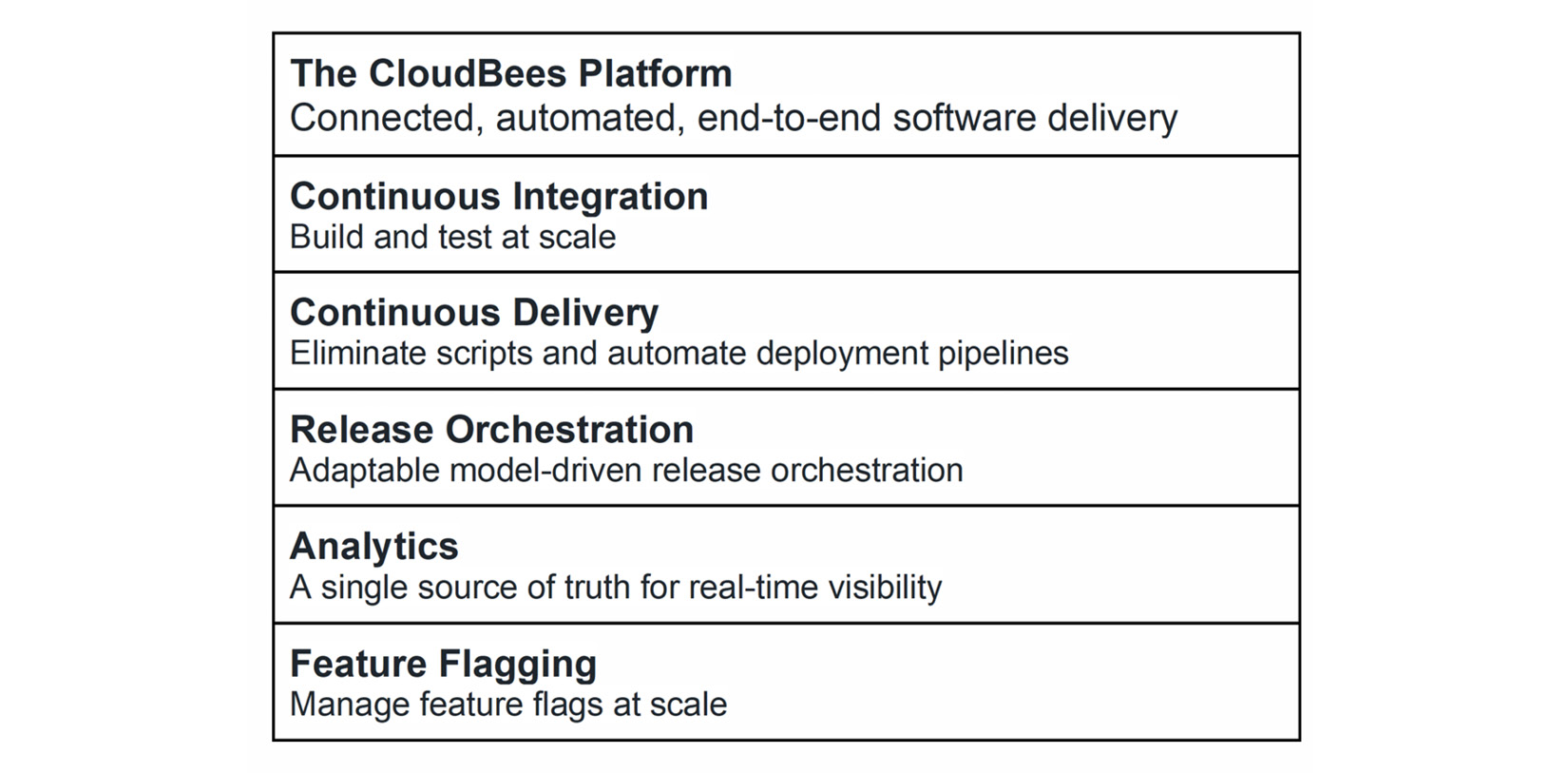
Figure 12.2 – CloudBees platform capabilities
CloudBees' platform supports what the company states are the five pillars of software delivery automation and management:
- Connected processes: Orchestrate software delivery and connect functions efficiently to bring ideas to market with maximum value and adoption.
- Compliance as Code: Centrally enforce policy, access, and standards across all pipelines and ensure the use of only approved, immutable components, automation, and environments.
- Common data model: Make data available from end to end and captured and stored in a standardized data model to facilitate collaboration, connected processes, and shared insights.
- Universal insights: Enable understanding and continuous learning from data across all functions throughout the organization.
- Continuous Collaboration and Improvement: Allow collaboration across functions and teams surrounding the software delivery organization to amplify their value creation and delivery efforts.
The CloudBees customer base has deep roots in the open source Jenkins development community; Jenkins is used to build, test, and deploy software in CI and CD environments. As a result, their tools place emphasis on improving development and deployment process efficiencies.
The CloudBees platform maps the value stream by modeling the software delivery pipeline from code commit into production. The pipeline model includes the path to production, approved components, gates and thresholds, testing orchestration, deployment automation, and toolchain integration (and data) in a graphical view. Built-in analytics include configurable dashboards for the DORA metrics and wait times, execution times, and durations for each stage. An AI/ML component produces risk scoring for each release based on developer, code base, and CI influences.
In their reports, industry analysts said they wanted to see CloudBees evolve their VSM capabilities to support improved business outcomes with better linkages to business metrics and dashboards. CloudBees has responded with additional metrics under development, including a range of flow metrics and business metrics such as value, cost, quality, and happiness.
In sum, on top of its strengths in CI/CD, release orchestration, and feature flag capabilities, the CloudBees platform offers the ability to map, manage, and govern a value stream end to end—from ideation to production—and provides superior support for integrating third-party tools.
Additional information is available on CloudBees and its offerings can be found at https://www.cloudbees.com/.
ConnectALL
ConnectALL's roots lie in developing adaptors and connectors for application lifecycle management (ALM) tools such as Sarena (now Micro Focus ALM) to other software tools for development, configuration management, and project management, including Perforce, ClearCase, and Jira, respectively. In addition, the company has continued to evolve its connectors to support integrations with IBM Rational, HEAT Software, Git, and Rally.
ConnectALL LLC was officially formed in 2018, created initially as a joint venture between Orasi and Go2Group. Discussions between Lance Knight and Brett Taylor (now a board member) began in December 2016 on the need for a new approach to value stream management. Lance Knight joined the company in 2017 as its President and COO, and he and Brett began to position ConnectALL for this move strategically. Also, Tom Stiling (Now the Chairman of ConnectALL's Board) joined the effort. As a result, the three partners began to establish ConnectALL as a separate entity in 2018, focused on VSM.
Andrew Fuqua, SVP of Products, joined the company in 2018 to help drive the company's product strategy. Also, Eric Robertson, SVP Strategic Advisor, was recently hired to guide the company's future as a leader within the VSM industry. The team's collaboration and resulting products have received favorable reviews from Forrester Research, Gartner, and SD Times.
The ConnectALL strategy has the goal "to deliver to 'the human side'" of software. Thus, while ConnectALL's integration tools are top-notch, they do not view VSM as limited to supplying integration tools and flow orchestration capabilities. Instead, they see much greater value from their VSM tools coming from human-driven assessments. The assessments help ConnectALL's customers discover areas to improve agility, traceability, predictability, and velocity. The VSM assessments, in effect, implement human-directed Lean improvement initiatives, as discussed in chapters 6 through 10 of this book.
ConnectALL's VSM assessments start before their customers make a VSM tools procurement investment, and the assessments continue beyond tool purchases. Most importantly, ConnectAll's VSM vision takes its tools beyond improving CI/CD and DevOps pipeline flows to align digital initiatives across the organization to improve business outcomes and improve the speed at which its customers can deliver software.
ConnectALL's focus in VSM is to help their organizations see, measure, and automate their value streams. They do this by connecting tools. While integration is undoubtedly an essential piece of ConnectALL's VSM solution capabilities, their larger vision is to connect tools as their primary value proposition. The connection of tools allows companies to gather metrics, draw value stream flows, analyze alternatives, and orchestrate preferred value stream flows.
A key differentiator for Connect ALL's products is its patent-pending Universal Adapter. The Universal Adaptor enables their platform to connect with any other tool with a REST API, making it possible to quickly integrate other tools across CI/CD and DevOps pipelines.
ConnectALL uses their Value Stream Visualizer as an aid in their Value Stream Assessment workshops. Figure 12.4 illustrates an example of a ConnectALL value stream map:
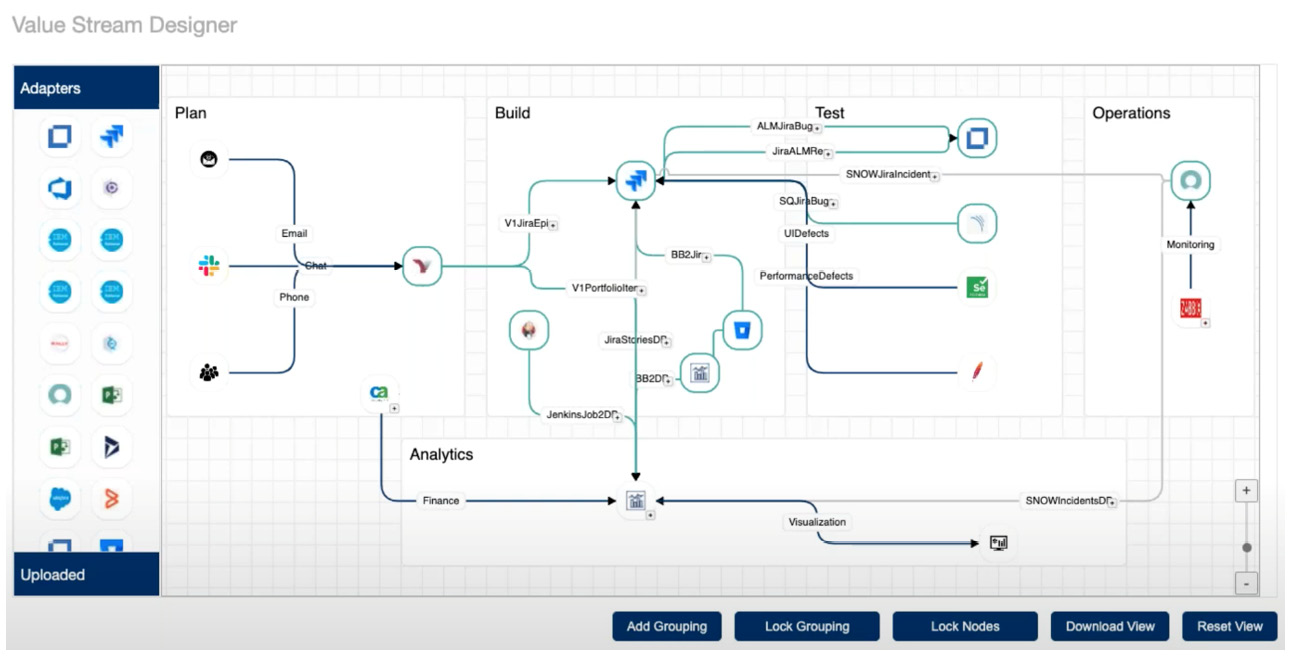
Figure 12.3 – ConnectALL's Value Stream Visualizer
ConnectALL's VSM platform offers four key capabilities: integration, flow metrics, workflow orchestration, and governance. Their VSM platform connects tools in your software delivery value stream by offering built-in vendor adapters for bi-directional or uni-directional synchronization of work and information flows across the entire value stream. The platform also offers workflow orchestration and governance capabilities out of the box.
ConnectALL's Insights Analytics product uses ConnectALL's Adapter to pull raw data from the disparate tools supporting your value stream into their standardized data model. In addition, the visualization capabilities of Insights make data for metrics such as flow, Lean, DevOps, and IT performance visible, transparent, and available.
You may be interested in this landing page, which includes some case studies: https://www.connectall.com/resources/case-studies/.
ConnectALL's website: https://www.connectall.com/
Digital.ai
Digital.ai has a unique VSM platform that addresses a common problem that most large enterprises face: keeping developers happy and productive by "allowing teams to select" and continue using their chosen tools. Doing so requires offering pre-built, intelligent integrations for hundreds of diverse DevOps solutions.
Digital.ai publishes the annual Periodic Table of DevOps Tools, consisting of practitioner-rated DevOps applications to make their point about disparate toolchains. The current 2020 version of their periodic table has more than 400 products across 17 unique categories. You can download it here: https://digital.ai/periodic-table-of-devops-tools.
The Digital.ai VSM platform connects the entire software delivery lifecycle, no matter your chosen tools and vendors. Compare Digital.ai's developer-friendly platform to the costly alternative of starting from scratch using a new set of technologies from a single vendor.
Initially, there are many perceived benefits to this approach, including access to cutting-edge technologies and new ways of thinking and solving problems, which is why it often tends to be an attractive initial consideration. But once the theory confronts reality, most enterprises find that a rip-and-replace of tools adds risk and complexity, increases downtime and costs, and often requires learning new tools and processes.
Even worse, hundreds of supporting processes and automation built around these existing tools may need to be changed. Applying this big-bang approach drains the team's energy and available capacity, moving the focus away from the goal of the digital transformation. Instead, the organization must become digitized to improve operational efficiency and become a digital business that can rapidly innovate.
Digital.ai's unified VSM platform connects your business and development value streams. It offers end-to-end oversight and governance of the DevOps pipeline and other supporting tools and organizations (portfolio planning, customer support, operations, and sales, among others) that help improve business outcomes.
While most value stream tools simply help improve software development and DevOps efficiency, Digital.ai's solution connects Agile planning and portfolio management, continuous testing, application protection, software development lifecycle management, release and deploy orchestration, and end-to-end AI-powered intelligence. Its platform enables large, complex enterprises to optimize the CD pipeline for maximum value delivery and quality instead of compliance with fixed delivery plans.
Digital.ai believes a VSM platform must provide end-to-end oversight and governance of the DevOps pipeline. It does this by integrating data across the entire software lifecycle toolchain, applying business analytics and AI/ML techniques to offer real-time visibility into business and development value streams metrics and KPIs, providing actionable insights (Figure 12.5):
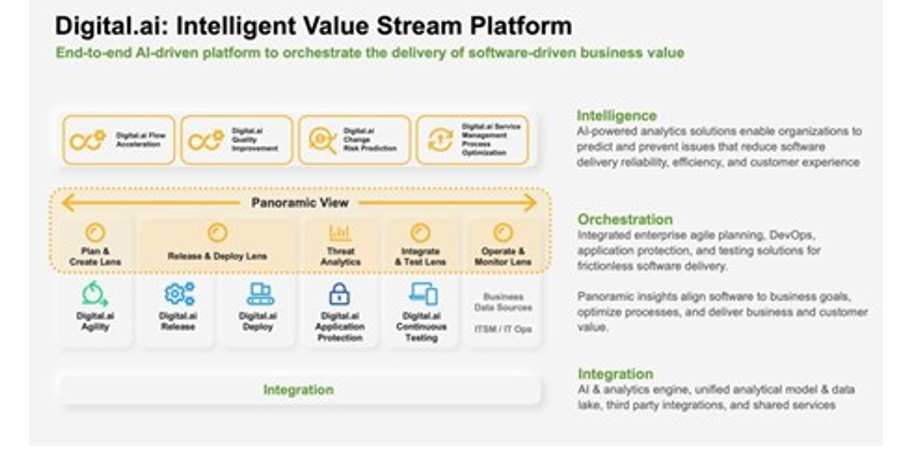
Figure 12.4 – Digital.ai: Intelligent Value Stream Platform
Digital.ai is one of the few (if not the only) VSM platform solution providers that has understood the need to apply AI/ML and connect business and development stream metrics and KPIs. Their VSM platform helps accomplish this goal by providing a unified data model and the pre-built metrics and dashboards necessary to assess the flow of value to customers.
As an example of these capabilities, Digital.ai employs AI/ML to look inside and across organizational silos to aggregate data, forming a holistic view of information. It then offers actionable insights across sales, marketing, finance, development, operations, and technology teams.
Digital.ai offers several solutions that support value stream intelligence and managing the risk of change. These include the following:
- Analytical lenses for the Plan and Create, Integrate and Test, Release and Deploy, and Operate and Monitor lifecycle segments, as well as a panoramic lens for total lifecycle views that combine business and technology data
- AI and ML to optimize service management, change risk prediction, flow acceleration, and quality improvement
Value stream orchestration solutions from Digital.ai include the following:
- Agility for agile planning and portfolio management (formerly Collabnet | VersionOne)
- Release and Deploy DevOps solutions for release and deployment orchestration (previously XebiaLabs)
- Continuous testing (formerly Experitest)
- Application protection (previously Arxan)
More information on Digital.ai's solution is provided in Section Two of the book, Identifying VSM Methodology Providers.
The essential elements of Digital.ai's Value Stream Platform are as follows:
- Applied Intelligence: The Digital.ai platform automatically and intelligently guides software delivery orchestration to accelerate the flow of value and predict change failures and schedule risk.
- Common Data Model (CDM): Digital.ai's CDM facilitates aggregating and harmonizing data and applying AI and ML. Digital.ai's robust AI platform capabilities analyze data across all value streams, creating a 360-degree digital view of business outcomes and technical outputs.
- Normalized View: The CDM supports an intelligence layer, which provides a holistic view, or lens, of a customers' digital world appropriate for consumption by technical executives and business leaders.
- Panoramic 360° digital view: A 360-degree view enables value delivery improvement from concept to cash, aligning technology improvements with the organization's broader business goals and objectives.
The key highlights of the Digital.ai value stream platform are as follows:
- Multi-tenant, purpose-built-for-cloud hosting or on-premises deployments.
- Shared services (for example, user management, single sign-on, licensing) enables seamless collaboration and alignment of users, tools, methodologies, and teams.
- The CDM and platform integrate data across various tools and business systems.
- Analytic lenses offer a panoramic, 360-degree view that allows business and technology groups to finally align and measure the impact of technology investments on business outcomes.
- Intelligent software lifecycle orchestration applies AI and ML to visualize all the work necessary to produce solutions and identify delays, bottlenecks, handoffs, and excess work-in-progress.
- Built-in AI/ML identifies potential change failure and reduces associated incident mean time to resolution (MTTR). In addition, it can look back and investigate systemic root causes of technology change issues that span people, processes, and technology.
- Apply AI/ML models that find, predict, and address issues across the value stream, supporting data-driven decisions.
- Connect development outputs to business outcomes to understand the impact of technology investments to develop new features and products.
The Digital.ai value stream platform offers visibility across teams, tools, and processes. As a result, organizations can effectively measure value and quality, such as customer satisfaction and retention, application usage and security, execution efficiency, revenue, and growth.
Besides supporting all major Agile (Scrum, Kanban) and scaling frameworks (SAFe, DA, LeSS), Digital.ai promotes a VSM methodology, which optimizes people, processes, and technology to continuously improve business value flow, from ideation to customer delivery.
In Digital.ai's view, measuring output metrics (such as the number of features created, cycle time, velocity, and the number of deployments) is only part of the VSM story.
Digital.ai offers a complete set of DevOps offerings that help organizations dramatically improve their IT organization's Lean outputs and connect them to customer experiences and business outcomes. This approach creates an unparalleled view of potential improvements that can move the needle toward better business results.
Digital.ai provided two cases for this book. The first use case is from a large U.S. insurance company that uses Digital.ai's software tools to support their digital transformation activities:
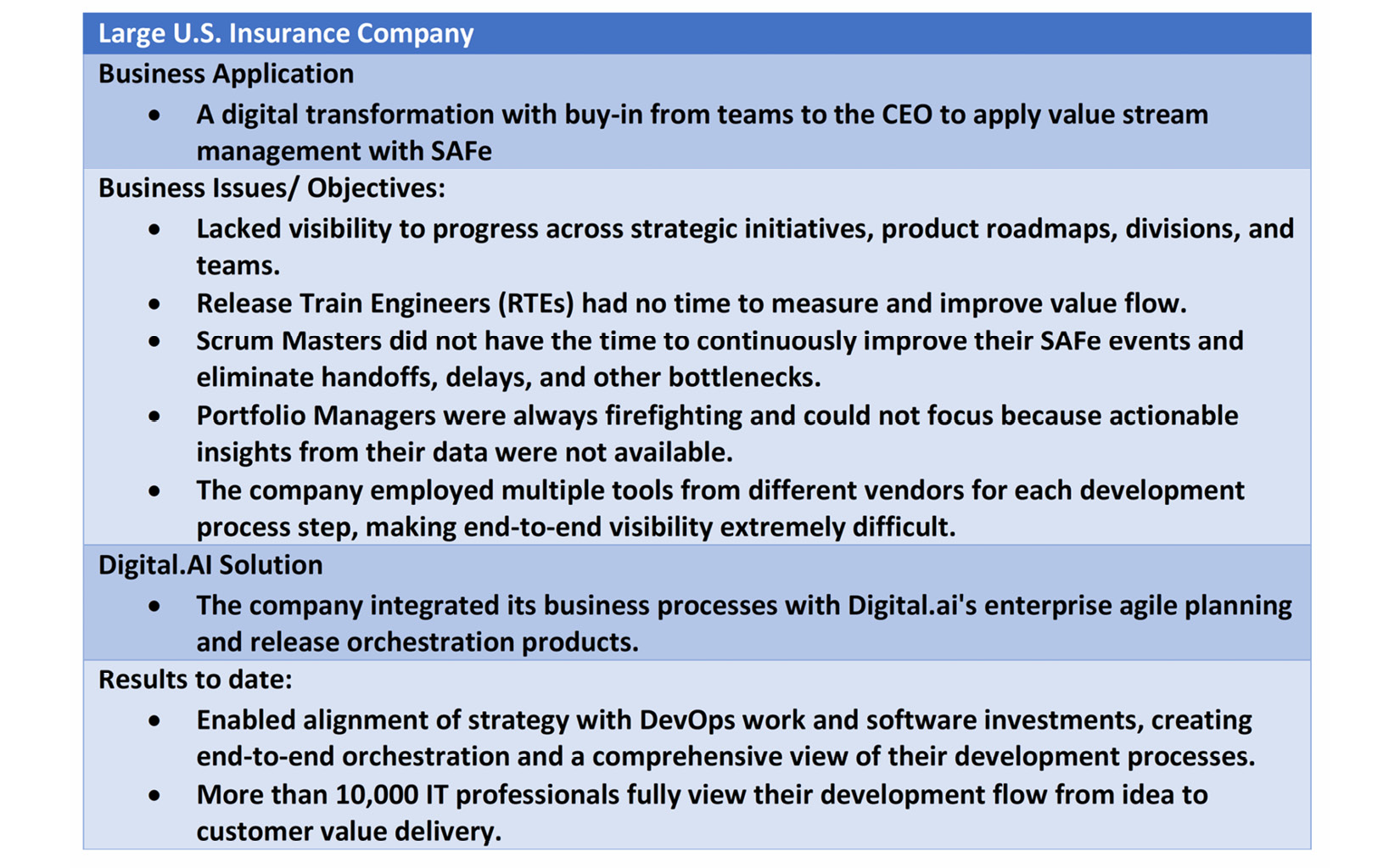
Figure 12.5 – First use case
The following Digital.ai use cases highlight a global retailer's experience of using Digital.ai's software products to provide end-to-end visibility across the disparate tools used in their DevOps pipelines and evaluate the effectiveness of their value streams:
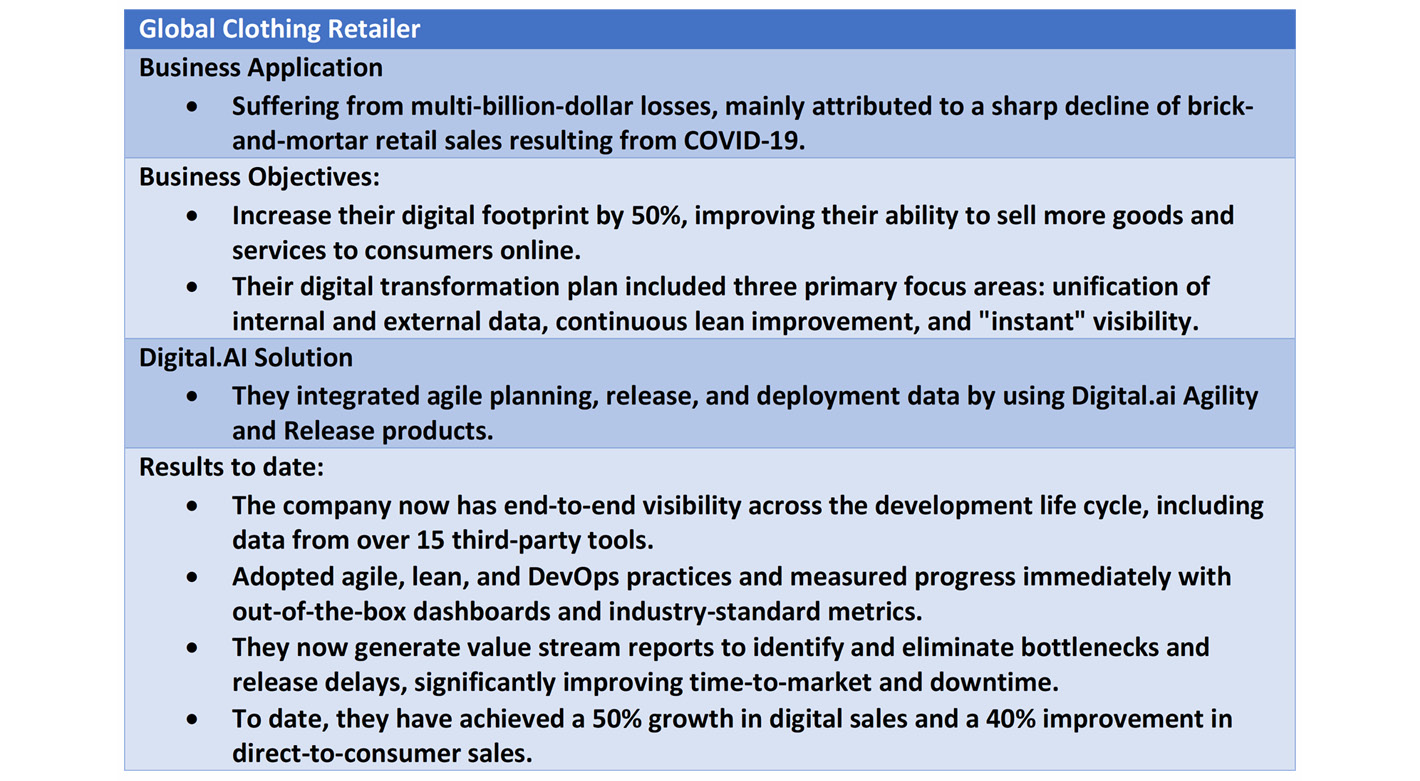
Figure 12.6 – Digital.ai use cases
Digital.ai's website: https://digital.ai/
GitLab
GitLab is acknowledged as a VSM leader by several industry analysts, such as Forrester Research and GigaOM. GitLab is fundamentally a DevOps platform provider. The GitLab DevOps platform integrates planning, development, operations, and security teams via a single application. GitLab also promotes their platform's ability to help "teams accelerate software delivery from weeks to minutes while reducing development costs and security risks."
With its end-to-end DevOps platform, GitLab enables end-to-end visibility throughout the entire software delivery lifecycle. But since GitLab provides the necessary tools in one application, the software development teams avoid the so-called DevOps toolchain tax that occurs when the teams must also support the development and sustainment of the DevOps toolchain integration and automation capabilities.
Put another way, the DevOps toolchain tax is the added cost of the development team having to support two simultaneous software delivery activities. One activity supports the development of their customers' products – value-added work from our customer's perspective. The other set of activities supports developing their DevOps pipeline environments – which is not value-added work.
GitLab's Value Streams Analytics is an out-of-the-box feature that helps teams visualize and manage the overall DevOps flow cycle time from ideation to customer delivery. GitLab's Value Streams Analytics provides reporting on common workflows and metrics from a single data model.
Though customizable, GitLab's Value Streams Analytics provides default stages to represent the GitLab flow, including the following:
- Issue (Tracker): Time to schedule an issue (by milestone or by adding it to an issue board)
- Plan (Board): Time to first commit
- Code (IDE): Time to create a merge request
- Test (CI): Time it takes GitLab CI/CD to test your code
- Review (Merge Request/MR): Time spent on code review
- Staging (Continuous Deployment): Time between merging and deploying to production
GitLab also provides default labels for eight types of Issues: bug, confirmed, critical, discussion, documentation, enhancement, suggestion, and support. In addition, GitLab promotes their single-click drill-down capabilities to the level of work items, allowing the teams to remove blockages immediately upon discovery. GitLab also provides Scoped Labels and mutually exclusive labels (such as workflow::edit and workflow::design) that can be used to model custom workflows, which can then be visualized using Kanban-style boards or the Insights dashboard: https://docs.gitlab.com/ee/user/project/insights/#insights.
From the perspective of the software delivery teams, GitLab provides a single tool, eliminating the toolchain integration and automation headaches of managing disparate tools otherwise required to sustain a mature DevOps pipeline. Most importantly, GitLab's DevOps/VSM platform strategy gives the developers time to deliver value and means they do not have to spend time resolving technical debt issues associated with managing their DevOps environments.
GitLab's VSM page can be found at https://about.gitlab.com/solutions/value-stream-management/.
HCL Software
HCL Software is a division of HCL Technologies that develops and delivers more than 50 software products innovative software products built around DevOps, digital, IoT, cloud, automation, cybersecurity, and infrastructure management. It is one of the largest software providers in this review, with over $1 billion in annual revenue and 4,200 employees operating in more than 50 countries, counting more than 20,000 enterprise customers.
HCL Software DevOps, shown in Figure 12.5, is a key pillar of the portfolio, offering a complete and intelligent enterprise software value stream platform from planning to production and from mainframe to microservices:
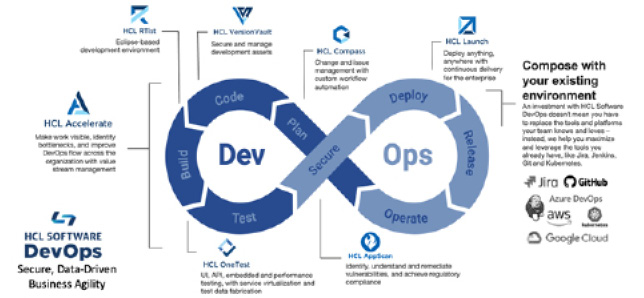
Figure 12.7 – HCL Software DevOps
HCL Software DevOps is a suite of best-of-breed product offerings that are loosely coupled yet highly integrated across the portfolio and the ecosystem of DevOps tools. Additionally, an open plugin framework allows enterprise customers to quickly connect one or more of the solutions into their existing environment. Customers looking for a comprehensive DevOps solution may adopt the entire platform. Figure 12.5 shows the set of products, which includes the following:
- HCL Accelerate: An intelligent VSM platform that enables continuous improvement by integrating with many tools across DevOps environments to visualize value stream flow, capture actionable insights, and automate release processes.
- HCL OneTest: An integrated suite of software automated testing tools including UI, performance, and API testing throughout project lifecycles. It features a scriptless, wizard-driven, test authoring environment and supports more than 100 technologies and protocols.
- HCL AppScan: A suite of comprehensive application security testing and management offerings including SAST, DAST, IAST, and SCA on web, mobile, and desktop apps that integrate directly into your software development lifecycle tools and processes.
- HCL Launch: A CD engine that automates application deployments, middleware configurations, and database changes to on-premises and cloud-based development, test, and production environments.
- HCL Compass: HCL Compass is a powerful low-code DevOps workflow engine that enables enterprises to quickly stand up custom processes for Agile management, quality management, IT service management, and more.
- HCL VersionVault: HCL VersionVault is a secure, enterprise solution for version control and configuration management. It provides controlled access to soft assets, including code, requirements, design documents, models, schematics, test plans, and test results.
- HCL RTist: HCL RTist is an Eclipse-based modeling and development environment for creating complex, event-driven, and real-time applications. It is specifically designed to help software engineers with feature-rich tooling for design, analysis, building, and deploying embedded, real-time systems and IoT applications.
HCL Software DevOps offerings have been designed to help the most complex organizations, often in regulated industries, that require advanced approaches to minimizing risk, managing cost, and driving revenue. Many improvements can be achieved through DevOps Day 1 solutions that are primarily focused on automation in a CD pipeline. These solutions include establishing an automated, controlled path to production typically enabled through CI, CD, test, and security tooling. The ROI of these practices using HCL Software DevOps solutions has been well documented and summarized as better quality, faster time to market, lower costs, and higher employee morale.
As DevOps has entered its second decade, HCL has found their forward-thinking customers often are focused on addressing DevOps Day 2 challenges, which include the following:
- Connecting IT value to business value
- Adapting organizational culture and alignment
- Scaling best practices across the enterprise
- Optimizing flow across the end-to-end value stream
- Managing across many tools and decades of technology platforms
- Minimizing risk from security and quality exposure
- Shifting security, quality and governance left
- Increasing the frequency of production releases
With HCL Accelerate unifying the value stream, enterprises are enabled to address these Day 2 challenges. Software delivery can be established as a core enterprise competency that aligns IT activity to business outcomes for success in this digital age. The ability for organizations to proactively and effectively create business agility, secure products, and resilient operations using HCL Software DevOps is showcased in Figure 12.6:

Figure 12.8 – HCL Software DevOps intelligent value streams
Beyond product capabilities, HCL enables customers to succeed by providing a white-glove service and support experience atypical of large enterprise software providers. This approach is derived from HCL's roots in the IT service business and is tangible from first engagement to pilot to enterprise-scale operations. Early in the process, technical advisors will host no-fee value stream workshops to identify improvement opportunities and define a path to achieving business objectives. Then, utilizing the HCL SoFy (hclsofy.com) cloud-native environment, customers can spin up instances of the HCL Software DevOps products for hands-on demos and trials. Finally, as customers move forward with implementation, HCL assigns customer advocates to accounts for regular collaboration to ensure maximum business results are achieved. This approach has led to some of the highest Net Promotor Scores (NPS) in the industry (NPS 60+) and deep customer success.
To learn more about HCL Software and its VSM platform, visit https://www.hcltechsw.com/DevOps/.
Kovair
Kovair Software is a Silicon Valley software product company that provides integrated software tools supporting global product development and management. Historically, Kovair is known for its Omnibus Integration Platform – an Enterprise Service Bus (ESB) platform that integrates 110+ third-party (best-of-breed) software tools and other applications via their off-the-shelf integration adapters and plugins. In addition, Kovair's integration platform supports DevOps, application lifecycle management (ALM), and project portfolio management (PPM) requirements.
However, Kovair also promotes their platform's support for digital transformations and installing VSM solutions that provide visibility across the organization's business. In this context, Kovair is rebranding the company's products along the lines of Kovair VSMP (Value Stream Management Platform), Kovair VSDP (Value Stream Delivery Platform), Kovair PPM (Project and Portfolio Management) for DevSecOps, and Omnibus as its integration Platform as a Service (iPaaS)-based integration platform.
Kovair VSMP/VSDP solutions are already capable of merging organizational data, processes, and applications from legacy ALM into the cloud with DevSecOps. For example, Kovair's Project Portfolio Management and its iPaaS-based Omnibus serve a VSMP framework. And Kovair promotes its ALM and DevOps platforms as VSDP solutions.
Kovair automates toolchains with workflow and policy engines to help create a system of automated governance and visibility across all business communications and best-of-breed third-party solutions, including new solutions such as Smart City 5G Enablement of Services and Digital Transformation. Finally, Kovair can also help IT transform itself from a cost center to a value center, with business outcomes integrated and managed.
Though not currently recognized by Forrester Research or GigaOM, Kovair Software was recognized in Gartner's 2020 Market Guide for DevOps Value Stream Management Platforms, and SD Times also reported on Kovair's VSM capabilities in their article titled A guide to value stream management solutions (SD Times, January 6, 2021).
Kovair's VSMP solution serves as a Sales Pipeline CRM for Capturing Revenue Opportunities, with dashboards of KPIs related to business outcomes, which is unique. In other words, Kovair metrics track lifecycle costs for all organizational value streams and products, not just software. And they tie their value stream metrics to projected and realized revenues, not just cost savings.
Kovair also promotes its VSMP as offering unique capabilities in the following areas:
- Targeted and systematic waste reduction: Kovair provides a unified view to senior management, through middle management to the operations, administration, sales, and logistics teams. This capability enables early detection of bottlenecks and the elimination of waste at every step of delivery.
- Ensure Process Governance: Kovair offers a task-based workflow both at the macro and micro levels to ensure governance across and within every team involved in delivery.
- Improve cross-functional collaboration: Kovair enables collaboration between tools, processes, and teams over a hybrid infrastructure environment.
- Gain improved productivity: Kovair provides complete visibility across the triple constraints of time, resources, and costs, enabling better productivity through efficient use of resources.
- Increase Process Efficiency: Kovair offers secure and efficient integration seamlessly with best-of-breed applications via Kovair's award-winning Omnibus multi-cloud iPaaS solution.
- Continuous Product Lifecycle Management: Kovair offers complete project and portfolio management capabilities.
- Seamless iPaaS Integration: Kovair offers third-party integration with best-of-breed solutions.
- Concurrent Multi-Modal IT: Kovair offers multiple IT methodologies, Waterfall, Iterative, V-Model, and Agile (Scrum and Kanban), all from a process-driven platform.
Kovair's software products offer task-based workflow implementation and visualization capabilities of crucial software development activities with associated data that help product teams discover areas for improvement to optimize value stream flows.
Kovair does not enforce or promote a specific VSM methodology. Instead, Kovair allows existing or newer project management processes and methods to be ideated and deployed with Kovair's Workflow Engine, with process automation, governance, and project and portfolio management.
Readers can find more information on Kovair's platforms at the Kovair Software website: https://www.kovair.com/.
Micro Focus
Micro Focus is one of the world's largest enterprise software providers. Their products deliver trusted and proven mission-critical software that keeps the digital world running. With a pragmatic, disciplined, customer-centric approach, enterprises can run and transform to succeed in today's rapidly evolving marketplace. Micro Focus' portfolios span a diverse set of capabilities across IT operations, cybersecurity, information governance, mainframe, big data, and application delivery.
Micro Focus needed to transform its company through DevOps to empower their customers with their own digital transformations and grow its business. To drive this change, Micro Focus created a software factory that aligned its strategic planning with an integrated set of tooling, services, data, and processes that enables the company to plan, build, test, release, operate, and manage the software delivered to their customers.
The company's journey started with a gap analysis into how they deliver and enable end-to-end value streams. They categorized these into four initial components: Plan (strategy-to-portfolio), Build (requirement-to-deploy lifecycle), Request-to-Fulfill (R2F), and Detect-to-Correct Lifecycle (D2C). As products pass through the activities of a chain, they gain value at each step along the way. A value chain framework allowed Micro Focus to identify the activities that are especially important for the advancement of strategy and attainment of goals.
Micro Focus's application delivery solutions are a critical component of the software factory. They allow teams the freedom and autonomy to move quickly coupled with a central point of visibility and a layer of governance that aligns to business objectives. With an open framework, teams can integrate the vast ecosystem of tools to optimize the flow of work, reduce the overhead in managing complex toolchains, and provide insights to improve continuously.
Micro Focus' integrated solution approach allows value stream participants to visualize and contextualize the activities in a product value stream and track flow and value through multiple phases. Embedded across these solutions is the ability to ingest and intelligently analyze data across multiple sources to observe trends, identify bottlenecks, find correlations, and detect anomalies to foster continuous improvement.
The approach solves common challenges faced by enterprise organizations, such as lack of prioritization of high-value customer demand, inability to track flow across a product value stream, and poor understanding of process friction and execution constraints. Key products include the following:
- Project and Portfolio Management acts as the business backbone to establish strategic vision and goals and align to epics, features, product backlog items, and user stories.
- ALM Octane serves as the central nervous system where work, risk, and quality are managed from planning to release.
- PulseUno provides a single unified, secure, Git-based developer platform to track the value of change across code, build, review, and artifact capture.
- Continuous testing solutions for functional (UFT), performance (LoadRunner), and application security (Fortify) scales automated testing as part of the software delivery pipeline at every commit, every step or gate, and through to production.
- Deployment Automation seamlessly enables deployment pipeline automation, reducing cycle times and providing rapid feedback on deployments and releases across all your environments.
Micro Focus takes a software factory view to install DevOps capabilities. Additional background on this topic can be found here:
- DevOps at scale: How to build your software factory: https://techbeacon.com/devops/devops-scale-how-build-your-software-factory
- Create a software factory to evolve DevOps and speed transformation: https://www.microfocus.com/en-us/digital-transformation/our-perspective/software-factory
For more information on the company and its products, visit the Micro Focus website at: https://www.microfocus.com/en-us/solutions/accelerate-application-delivery.
Plandek
Plandek provides a complete Agile and delivery metrics business intelligence (BI) platform that provides an end-to-end view of their clients' software delivery cycles. While it is not a complete VSM platform solution, Gartner recognized its platform as a global top 10 vendor in Gartner's new DevOps Value Stream Management Platforms Market Guide.
Their vision is to apply data science to the software delivery process, offering intelligent insights to deliver software products better. Teams use Plandek's predictive data analytics capabilities to reveal hidden risks, improve end-to-end delivery performance, and address their thorniest software delivery questions, such as the following:
- Are we achieving the goals of our Agile, DevOps, and business transformations?
- How can we help our Agile teams deliver value more quickly and predictably?
- How can we objectively compare the performance of our software delivery teams?
- How can we shorten the time to market and increase velocity?
- How are we performing compared to other companies in our industry?
- How can we give our teams the metrics they need to improve as a continuing process?
SD Times claims Plandek has unique integration and data mining capabilities that enable it to integrate with multiple value stream delivery toolsets (for example, Jira, Git, Jenkins, Azure, and DevOps) to obtain pipeline metrics. In addition, Plandek's data mining capabilities provide access to delivery metrics from end to end across the pipeline, exposing patterns so that their customers can make informed decisions to improve software delivery efficiencies, quality, velocity, and predictability.
Plandek also provides customizable dashboards that provide visibility to critical metrics and KPIs allowing product delivery teams to do the following:
- Empower teams to deliver valuable software faster, more predictably, and more frequently.
- Reduce delivery and infosec risk and improve governance at scale.
- Put value stream metrics and analytics at the heart of VSM initiatives.
Plandek gets high marks in the following areas:
- Stack and process agnostic
- An analytics solution that does not require an orchestration layer
- Enterprise scalability and security
- Offers a complete end-to-end view of software delivery pipelines
- Supports team collaboration, continuous improvement, and product visibility and reporting
Plandek offered two case studies for inclusion to demonstrate the effectiveness of their metrics and analytics platform as a DevOps VSM point solution.
Figure 12.7 summarizes the first case study offered by Plandek:

Figure 12.9 – Plandek customer use case #1
And Figure 12.9 summarizes the use and results of a second Plandek customer use case:

Figure 12.10 – Plandek customer use case #2
Plandek provides a robust BI capability to support decision-making gathered from the toolchains that support end-to-end CI/CD and DevOps pipeline activities.
Plandek's website: https://plandek.com/
Plutora
Plutora offers a highly rated VSM platform recognized as a leader by the Enterprise Management Associates (EMA), Forrester Research, and GigaOM. They are also a founding member of the VSM Consortium.
Plutora promotes their VSM platform as providing a complete software delivery management solution engineered to improve time-to-value. In this context, the Plutora platform offers the following capabilities for software delivery management support:
- Value Stream Management: Seamlessly brings together product owners, release and development managers, risk and compliance teams, and engineering and deployment teams to deliver value and support continuous end-to-end improvements across the SDLC.
- Release Management: Define and schedule hierarchical releases, track dependencies, manage approvals, and maintain compliance while accelerating change across the entire enterprise portfolio.
- Test Environment Management: Centralize bookings, resolve conflicts, and track system dependencies. Eliminate error-prone manual configuration management and change control processes.
- Deployment Management: Helps streamline deployment processes across teams to minimize risk and accelerate cut-over events. Manage the planning, approval, coordination, and execution of production cut-over activities across multiple teams. Use analytic capabilities to streamline audits and inform post-implementation reviews.
- Predictive Analytics: With integrated and normalized data from end to end, made visible through customizable dashboards, users have a single source of truth for software delivery from idea to production on an enterprise scale.
It's essential to note that Plutora positions its VSM platform as a software development data platform, providing the infrastructure necessary to integrate, automate, and orchestrate software delivery pipelines. Most importantly, its data-centric VSM platform, robust analytics engine, and common data model provide real-time access to critical data for decision making. In their words, "it all comes together in the analysis and display of our rich set of metrics and dashboards that provide organizations with the insight they need to deliver the most value to their customers through their development efforts."
Plutora recognizes that many project management and tools embed useful VSM data and analytical capabilities. However, the challenge for decision-makers is to navigate multiple value stream dashboards, then make sense of end-to-end pipeline flows. For these reasons, Plutora promotes the need for a dedicated analytics platform that pulls data from multiple platforms.
Overseeing your software delivery process
The Plutora VSM platform provides a comprehensive set of tools to oversee the entirety of your software delivery people, processes, and tools. Plutora's VSM platform works regardless of management methodology, automation support, or the third-party tools employed by the organization. Its purpose is to help scale Agile and DevOps strategies across the enterprise.
Figure 12.9 graphically portrays the three categories of tools within Plutora's VSM Platform, Decision Making & Analytics, Management & Orchestration, and Integration & Common Data Model:
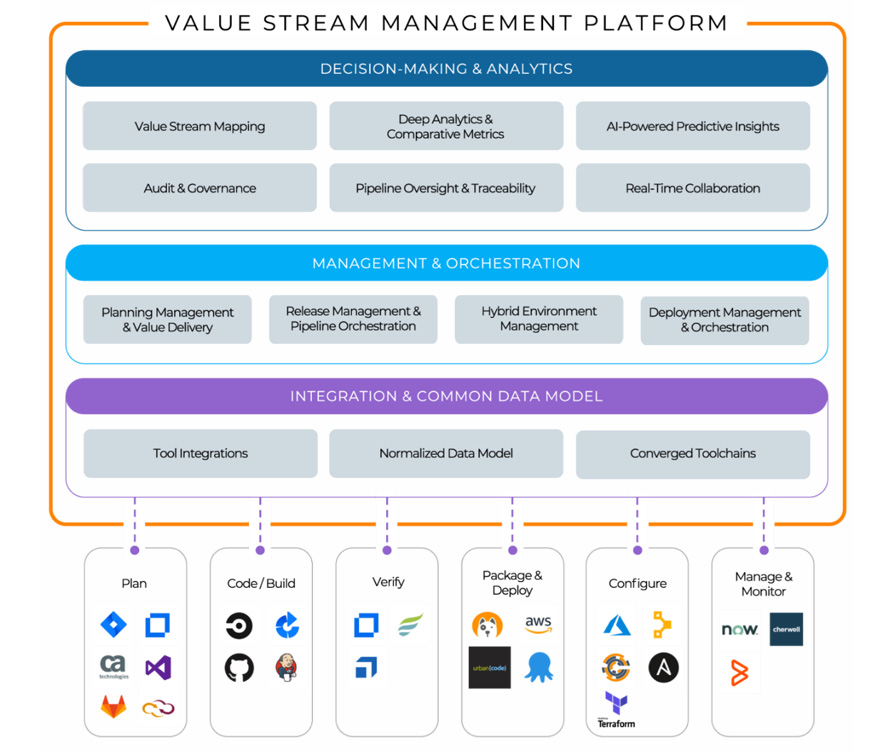
Figure 12.11– Plutora's VSM platform
Plutora's platform implements a Decision-making and Analytics layer at the top-most layer that captures, manages, and provides access to SDLC data related to your KPIs. This layer also provides access to pipeline metrics and predictive analytics capabilities to support software deliveries across your digital business.
Plutora's out-of-the-box metrics and reporting capabilities (including monitoring the DORA Four metrics) provide accurate and near real-time information on pipeline flows. In addition, Plutora's dashboards display metrics encompassing measuring performance against the release planning process against business-facing outcomes and priorities.
Plutora recently released an expanded data-centric VSM platform that offers enhanced VSM flow metrics. The flow metrics help organizations monitor and manage value stream flows to measure efficiency and identify bottlenecks more precisely across software delivery pipelines continuously. With its data-centric platform and common data model, Plutora's customers can manage the metrics for any pipeline, development style, or tooling to achieve greater business outcomes through enhanced data-driven decisions.
Plutora's Management and Orchestration layer provides control, visibility, and automation of DevOps pipeline flows at the mid-tier layer. A significant and recent improvement in this layer is Plutora's Planning Management and Value Delivery capabilities supported by deeper integration with planning tools and a common data model across disparate tools. Plutora's common data model was always there. But the new release enhanced it with its planning management integration; plus the company has built additional scale into the platform to reflect its changing utilization as a mature data platform.
The enriched data offers a complete time series and change history across product lifecycles and software delivery flows. Product leaders can utilize enterprise-class analytics and reporting tools to achieve complete visibility across the entire portfolio and produce data that can identify trends and patterns in the software development process with time-based analytics.
Plutora's VSM platform provides the means to orchestrate work across your disparate CI/CD and DevOps toolchains. Release and deployment management are obvious orchestration applications. However, an equally important need is to orchestrate pipeline work in a hybrid environment. For example, it may be necessary to integrate applications on-premises that need to persist alongside other applications within a cloud environment.
The Integration and Common Data Model layer provides connectivity to the organization's CI/CD and DevOps tools, Agile planning tools, project portfolio management (PPM) tools, and production and post-production tools, eliminating the need to use integration brokers to code point-to-point toolchain integrations. Instead, the platform's connectors integrate data from disparate tools and prove a standard and normalized data model to support end-to-end analytics across IT value streams. This integration and analytics spans the entire value stream, from idea to cash, including Agile and DevOps-oriented people, processes, and tools.
As a value stream improvement and portfolio management tool, teams can model their value streams, store and manage metrics data, and reference the metrics individually across pipeline activities or rolled up into portfolio views. Product teams can implement controls, such as automated or manual review gates, governing build, release, and deployment activities. The provisioning of a standard data model with integrated analytic tools enables visualization of bottlenecks and areas of waiting, supports decision-making, and provides input into planning and resourcing activities.
Aligning software development with business goals
Plutora promotes their VSM platform as a tool to help fill the gap between business goals and software development, thereby reducing time-to-value. They further view this as a five-step activity:
- Managing your remote software factory, making work visible with smart dashboards and automating governance to improve organizational performance.
- Creating a single source of truth by integrating disparate data sources into a common and normalized data model that provides end-to-end and real-time views of your software development lifecycle activities.
- Giving full control, visibility, and automation across testing, deployment planning, and release management activities, orchestrating multiple pipelines from ideations to production, improving productivity, eliminating waste, and managing risks.
- Enabling a smart digital business by employing advanced KPIs, metrics, and predictive analytics across your entire software delivery process empowers your digital business. The idea here is that you cannot continuously improve the activities you do not continuously measure and analyze. Also, manage risks by automating governance and compliance requirements utilizing criteria gates and audit history.
- Reducing time-to-value by identifying choke points, eliminating waste, increasing efficiency, and reducing time-to-value to achieve a competitive advantage.
Improving the software delivery process
Plutora identifies many potential applications for VSM to improve the software delivery process:

Figure 12.12 – Potential applications for VSM
As a VSM solution, Plutora provides a robust integration, automation, and orchestration platform. The objective is to use Plutora's VSM platform capabilities to achieve a competitive advantage by identifying bottlenecks, eliminating waste, increasing efficiency, and reducing the time-to-value.
Plutora website: https://www.plutora.com/
Quali
Quali is another software company that does not explicitly address full-scale VSM platform requirements but provides necessary components within any CI/CD or DevOps pipeline. Quali's CloudShell Colony is an SaaS platform for delivering Infrastructure Automation at Scale. More precisely, CloudShell Colony offers self-service automation and governance capabilities to streamline application development, testing, and release into production. In addition, its software supports the deployment and governance of complex software applications on cloud technologies, including AWS, Azure, and Kubernetes.
Quali's inclusion in this list is due to its support of automating governance policies, one of Gartner's three categories in its definition of VSM tools: continuous compliance automation (CCA) tools. However, it would have to be purchased as an add-on to support broader VSM platform requirements within an enterprise.
The primary product Quali promotes to support VSM initiatives is CloudShell Colony, which was formally renamed Torque on June 22, 2021. Our primary strength comes from a consistent focus on making it practical, even easy, to leverage the application-centric environment as a primary organizing construct.
Quali's application-centric environment combines application, infrastructure, and data resources. Taken together, with all of its systemic dependencies and intricacies, as a whole logical unit, it provides a better way to continuously design, deliver, operate, optimize, and govern the cloud infrastructure resources needed to power development and DevOps value streams.
On the surface, this may not seem like a big deal because you can certainly use any number of tools and methods to discretely, or even in some combinations, automate the provisioning and configuration of these individual resources. Unfortunately, however, most have been designed around executing individual actions, leaving the larger context, the systemic logic, and dependencies to be defined manually, individually, and often inconsistently, if at all.
Torque by Quali takes the opposite approach, starting from an expectation that whole systems comprising multiple resource types and configurations are what developers and DevOps product teams need to develop and deploy. Ultimately, the IT operations teams are responsible for delivering, running, and governing the value prioritized by the product owners.
The previous statement does not mean to imply that only whole environments can be designed and delivered on demand by Torque; quite the contrary. Defining individual resource types does not constrain future abilities to automate the on-demand composure, the stitching together, of the different resource types to work together as desired. Users can also change cloud providers after the initial deployment without affecting the application-centric environment.
Another core strength comes from another combination of assumptions that Quali's product Torque was designed around:
- Managing cloud costs and policy compliance is essential for being good stewards of the business and representing a vital data source to identify inefficiencies and drive optimization efforts.
- Getting cost and policy compliance data that is accurate, timely, and useful is hard to do, and it's even harder to do without introducing speed-killing friction into the workflow.
- Environments and their supporting resources are rarely deployed from a lifecycle perspective, much less with an easy way to manage them from a lifecycle perspective. Products themselves and the products and value streams they support have a useful lifespan, after which they should be either refactored or retired.
Torque helps meet cost and governance needs by automatically tagging resources used with cost, policy, and role information in addition to the technical attributes that are, in turn, analyzed via Torque's reporting and dashboards or available for analysis in other tools.
Torque is also built from a product lifecycle perspective. Application-centric environments have an expected lifespan that, by definition, is used to help drive product (environments in this case) improvement and reduce cloud resource waste by automatically decommissioning unused resources.
Another critical capability of Torque is its utilization of and integration with DevOps toolchains, making it easier for developers, DevOps product teams, and IT operations teams to take advantage of its automation and orchestration capabilities. In this context, Torque becomes a natural part of their customers' workflows. For example, environments can be requested and delivered based on a code commit (triggering a CI/CD pipeline run) via the command line, API calls, or GUI.
Quali believes the totality of these capabilities positively impacts and provides additional insight into lead time, cycle time, throughput, WIP, flow efficiency, and work profiling.
Quali does not currently promote or employ a specific VSM methodology at this point. That said, they note that the two frameworks or value stream concepts they encounter most frequently in their customer engagements are SAFe and Gartner's DevOps Value Streams.
Quali provided a relevant customer case study from Resident (Figure 12.10) that they believe illustrates their products' positive impact even within ostensibly modern, digital businesses:
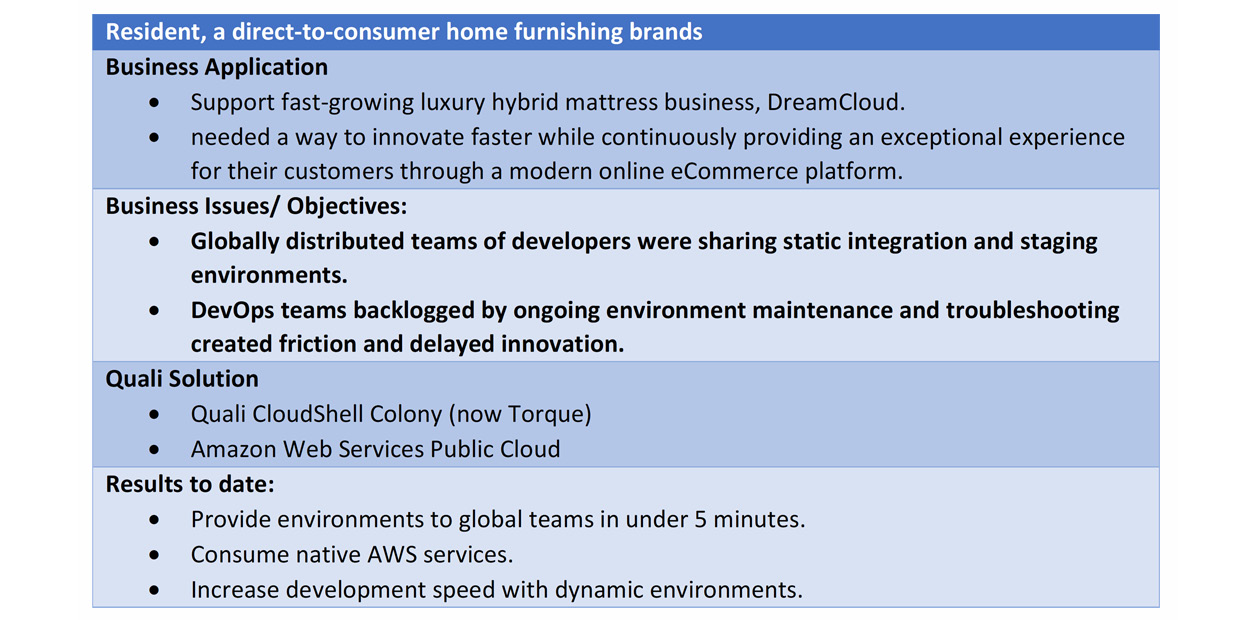
Figure 12.13 – Quali customer use case
Quali's primary value to improvement initiatives beyond IT/CI/CD or DevOps lies in their ability to facilitate faster and more specific experimentation with application releases and updates via their automation of blue/green deployments. For example, the marketing department wants to try a new set of messages targeted over a certain period, while business operations would like to offer new payment processing options before further rolling out a new release. Quali's Torque product helps simplify and expedite the feedback loop.
You can find more about Quali and its products at their website: https://www.quali.com/.
ServiceNow
ServiceNow offers a single platform, the Now Platform®, that integrates, automates, orchestrates software delivery pipeline flows. ServiceNow promotes its Now Platform as providing capabilities to "deliver cross-enterprise digital workflows that connect people, functions, and systems to accelerate innovation, increase agility, and enhance productivity."
The platform incorporates a single, unified data architecture that supports end-to-end pipeline visibility and analytics. As a result, ServiceNow users can trace pipeline activity flows from the customer to the developer through their data model.
ServiceNow recognizes that organizations need to deliver business value and that VSM offers the best approach to manage and improve the flow of value across the enterprise. It is in this context that ServiceNow employs VSM.
Many of ServiceNow's customers are still making the transition from projects to product-oriented management strategies. Therefore, DevOps platforms must support these transitions as hybrid software development and delivery environments in the short run.
ServiceNow delivers a wide range of capabilities beyond VSM through one of the most tool-intensive platforms in the software industry, with a comprehensive scope of products offered. Conceptually, ServiceNow promotes its products as supporting digital workflows to optimize how things get done for any business:
- IT workflows to optimize IT service operations, align investments with priorities, and manage risk, security, and costs.
- Employee workflows make it easier for employees to get the information they need when they need it, break down silos by supporting value-based delivery streams, and improve productivity.
- Customer workflows create a seamless customer experience and improve retention with the efficient delivery of services through customized self-service models.
- Creator workflows to help citizen and professional developers quickly and safely build cross-enterprise applications via low-code software capabilities and connected digital workflows.
ServiceNow offers one of the most comprehensive product lines in the software industry, with 47 products listed in their product directory. However, all of these products would only serve as point solutions if not for implementing workflow capabilities – used in context with VSM as the approach to affect Lean-oriented improvements across the enterprise.
VSM solution offerings
The point of ServiceNow's workflow strategies is to use information technology to support the implementation, visibility, and improvements of value stream delivery flows, no matter what the organizational structures might look like. Or, from the perspective of implementing Lean improvements, ServiceNow tools help organizations integrate, automate, and orchestrate their value stream flows. This approach is the only way organizations can break down the organizational silos that work against streamlined value deliveries.
VSM is an approach that customers can take utilizing the ServiceNow platform. Individual ServiceNow products that run on the Now Platform come into play depending on the use cases and methodologies that the customers wish to adopt.
The Now Platform provides the basics such as integration technologies, a standard data model that is called Service Graph, advanced analytics and reporting, action workflows, artificial intelligence, and machine learning. Figure 12.11 provides an example of how data from Service Graph helps organizations visualize interactions and results across a pipeline execution:
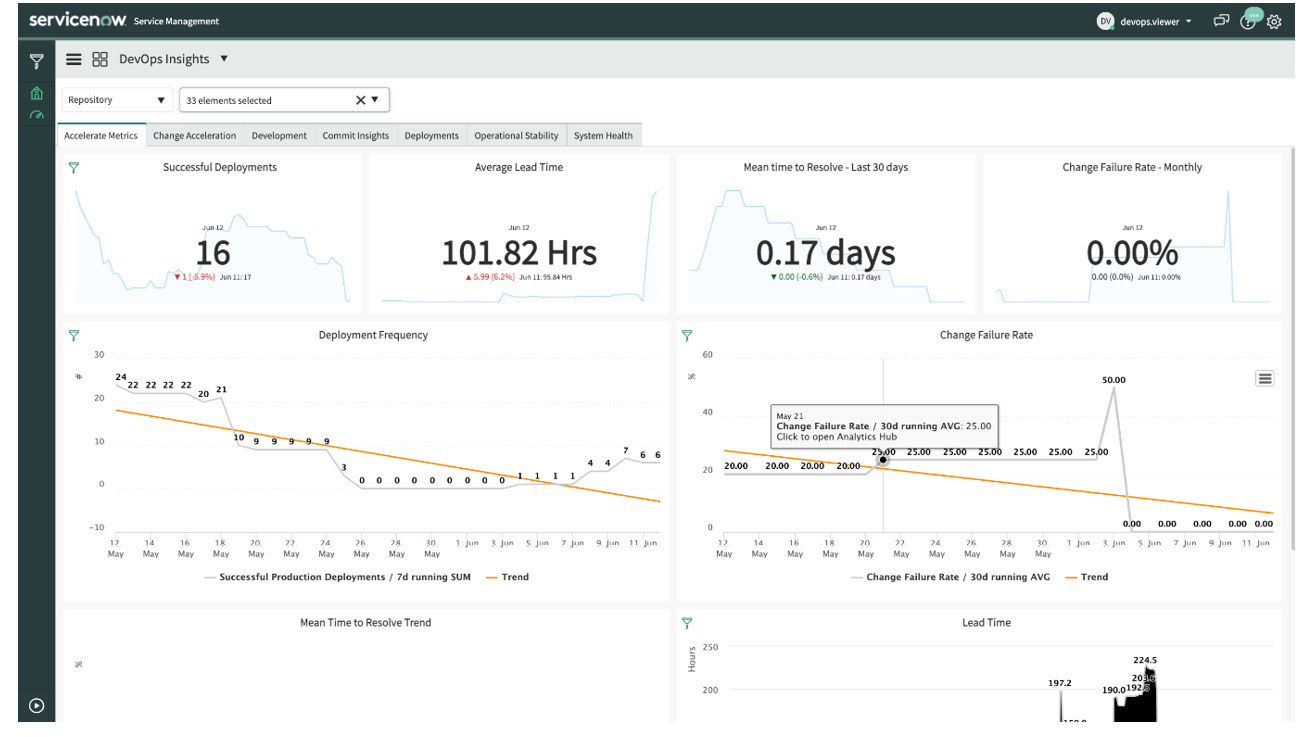
Figure 12.14 – Visualize interactions and results across a pipeline execution
An example of a use case might be a software product value stream where the Now Platform provides connectivity and insights into the plan-build-operate-service lifecycle. The essential ServiceNow products in the software product value streams are IT Business Management, DevOps, and IT Service Management.
Key differentiators and strengths
ServiceNow's key differentiator is the breadth and scope of the workflow and connectivity that is supported. For example, in the software value stream, many vendors in this space focus on the areas of delivery between code commit and deployment The ServiceNow approach covers the entire value stream from customer demand to product usage.
The Now Platform also connects to other management areas within an organization with the same single data model. Examples include their employee (HR) and customer service workflows.
- Pipeline integration platform:
a. Abstracted and correlated data model (across many types of sources).
b. Central platform tool for connectivity called the integration hub, alongside APIs and toolkits that provide out-of-the-box integrations to a wide range of targets (including and going beyond the DevOps tools and platforms), as well as the ability for partners and customers to easily add their integrations that use ServiceNow's workflows and data model.
- Metrics and analytics:
a. One connected data model from ideation to what is happening in production, especially if you are already managing production in ServiceNow IT Operations Management (availability and performance) and IT Service Management (management and governance). For example, showing the change failure rate (a commonly used accelerate metric) is easy as ServiceNow runs the systems that know when changes occur and when they fail.
b. Out-of-the-box insight dashboards with data normalized from all the sources make reporting across teams using different DevOps tools simpler.
c. Complete BI platform that supports deep analytics, real-time metrics, time series analysis, ease of customization, and personalization. A low-code/no-code approach to metrics creation.
- Linkages or strategies support other organizational value stream improvements:
a. Works with any data that can be brought into ServiceNow and connected to many other business systems and infrastructure monitors across organizations.
- Tools support integration, collaboration, and orchestration across Dev and Ops:
a. An information and management layer supports collaboration via tailored dashboards for each persona or role, delivering flow metrics and out-of-the-box DevOps metrics based on those promoted by Dora/Accelerate.
So far, we have discussed the Now Platform in the context of its many tools and capabilities. But equally important is how we apply their tools to support the organization's VSM initiatives.
VSM methodology
Customers can leverage the platform and products to implement the methodologies and use cases that best meet their needs. In addition, ServiceNow expects to focus on business outcomes (including capturing and managing financial data, collecting efficiency metrics, and identifying areas for improvement).
Many ServiceNow customers are taking a project-to-product shift facilitated by maintaining a hybrid approach while they make the transition, meaning that the project and program management functions can operate at a corporate or program level while working seamlessly with scaled Agile and team-based approaches.
Supporting Lean improvements beyond the IT organization
ServiceNow customers can use the platform from idea to production, get feedback from their end users, capture product ideas and demands, and provide strategic input into the product backlog with IT Business Management. They can also track the delivery process with ServiceNow DevOps and service their end users with IT Service Management or Customer Service Management.
Visibility in ServiceNow applications is not limited to measurements of pipeline flow and other Lean improvement metrics. For example, users apply the DevOps Pipeline UI view to show pipeline stage progression and details for each app, as shown in Figure 12.15:

Figure 12.15 – Set up user-created integrations for additional planning, coding, and test tools
This end-to-end workflow on a single platform with a single data model provides customers with excellent visibility into the process and opportunities for optimizing the value string beyond the technical teams. In addition to tracking the value being delivered, our platform also helps capture the cost of the value stream so that customers can make informed investment decisions.
Customer use cases
ServiceNow provided the following customer use case as an example of the employment of their platform to implement an end-to-end DevOps pipeline solution:

Figure 12.16 – Customer use case
A detailed description of the DNB use case is available at the following URL: https://www.servicenow.com/customers/dnb.html.
DNB notes the importance of managing and leveraging their product delivery value streams to improve performance and efficiency and encourage certain desired behaviors. Therefore, they encouraged developer behavior by providing fully automated change governance when the following conditions existed:
- You implement an approved CI/CD pipeline toolchain, and the deployment process is at least partially automated.
- You have a minimum set of mandatory data in your pipeline tools needed for the change ticket to be automatically approved.
- You have a set pipeline that separates environments used for production, user acceptance testing (UAT), systems testing, and development.
- You always run the different tests in dedicated environments.
- All tests run successfully.
- You have to find the schedule stating when you are allowed to deploy to production.
- You have no critical or significant incidents on your service.
DNB's use case highlights a critical point discussed throughout this book on the need to implement infrastructure as code (IaC) to support automated testing and provisioning of testing environments on demand. We will revisit this subject in Chapter 15, Defining the Appropriate DevOps Platform Strategy, and Chapter 16, Transforming Businesses with VSM and DevOps.
Readers can find out more about ServiceNow, the Now Platform, and the approach to VSM by visiting their DevOps website at https://www.servicenow.com/products/devops.html.
Tasktop
Tasktop is another industry-leading VSM platform vendor with high ratings from industry analysts, such as Forrester Research and GigaOM. The company's key message is Transforming businesses into high-performing tech companies.
In addition, its CEO and founder, Dr. Mik Kersten, wrote the Amazon best-selling book Project to Product, which helped explain to the software industry why we had to move away from the traditional project-based management philosophies to product-based management structures and strategies. Dr. Kersten's book also introduced the Flow Framework®, which provides a management framework and infrastructure model to help bridge the gap between business and technology. Moreover, it provides a guide on making the transition from focusing on projects to products.
The Flow Framework helps organizations align technology investments with business value by visualizing and measuring the value streams encompassing the complete set of activities that bring software or SaaS to the market. It also provides a common language to help guide business and technology stakeholders in setting priorities and measuring outcomes.
The Tasktop VSM platform, which implements the Flow Framework, is designed to provide the language, metrics, and models to practice VSM over any toolchain and any organizational structure. It has two primary applications, namely Tasktop Viz™ and Tasktop Hub, as depicted in Figure 12.13:

Figure 12.17 – The Tasktop VSM platform
Tasktop's VSM platform implements three critical capabilities for VSM that do not typically exist in-house:
- A blueprint for mastering software at scale
- A robust data capture and storage layer
- A scalable and adaptive business lens over raw factual data
While the platform provides extensive and sophisticated bi-directional integration capabilities, the connections also provide visibility to data and analytics. Connectors to 60+ Agile and DevOps tools provide pipeline data for visualization, decision-making, and triggering events based on user-defined rules.
The Flow Framework builds on an integration model that provides connectivity across Ideate, Create, Release and Operate lifecycle tasks. Building on the integration model is an Activity Model that provides traceability of artifacts produced by the organization's value streams. Finally, a Product Model aligns value stream activities with customer-centered deliveries.
Given its foundations in Lean, the Flow Framework seeks to improve flow in service of business results. But instead of the standard work and information flows of traditional Lean improvement practices, the Flow Framework evaluates the flow of four Flow Items in software delivery (Figure 12.14) and their relative distribution:

Figure 12.18 – Flow Items
The Flow Distribution model represents potential adjustments in the flow of features, defects, debt, and risk. These adjustments occur situationally and are commensurate with the product's lifecycle stage to maximize business value.
Flow Distribution is essential in helping businesses (product/line-of-business owners), and technologists evaluate cause and effects when adjusting flows. For example, optimizing for higher flow velocity for features to capture new market opportunities may come at the expense of working on other critical items, such as fixing bugs and reducing technical debt. The bugs cause negative reviews with customers, impacting future deliveries and sales, while the accumulating technical debt makes delivery of future enhancements increasingly difficult and expensive. Finding the right balance is crucial for the product's long-term success.
As with any Lean initiative, metrics and business outcomes are critical in Tasktop's Flow Framework, as shown in Figure 12.15:

Figure 12.19 – The Flow Framework: flow metrics and business results
Tasktop recognizes that many large-scale organizations, driven by their immediate needs for visibility and cost-efficiency, consolidate their DevOps toolchains around 2–3 core work management tools for Agile execution and IT service management.
Unfortunately, those are execution-focused tools, designed to support small Agile-oriented teams employing Scrum, Kanban, or Squad methodologies. Team-oriented tools are too siloed to support effective decision-making when executive leadership oversees budgets in the tens or hundreds of millions of dollars with thousands of technology practitioners.
Moreover, those tools' end-to-end pipeline support capabilities are minimal, not supporting PPM, UX design, compliance, InfoSec, testing, and other IT practitioners involved in the software value delivery chain. Eventually, the need for those purpose-built tools and systems of record becomes apparent, leading to an increasing number of siloed tools and pipeline data.
Organizations cannot overlay and abstract the end-to-end value stream data in such an environment, including all its constituent but siloed tool domains. As a result, their executives are bound to make misinformed decisions based on partial information.
Tasktop points to data from a Forrester Report that notes that line-of-business executives make 65% of tech-buying decisions. Therefore, it's imperative that IT becomes much more focused on generating business value and ROI (Craig Galbraith, Forrester, 2020).
Tasktop promotes its ability to deliver precisely that business-focused visibility in support of data-driven IT investments, helping technology and product leaders implement a managerial framework fit for the Age of Software.
Moreover, Tasktop's products replace pen-and-paper value stream mapping exercises and thereby take the practice of VSM into our digital economy. The end-to-end views supported by Tasktop's tools generate a live, shared, and actionable view of how to accelerate value creation in software portfolios.
Tasktop promotes the following benefits experienced by their customers:
- Shorten time-to-market by an average of 75%
- Can identify where to spend their next dollar
- Have visibility to see live value stream maps, lit up with their bottlenecks
- Can make the shift from projects to transparent and measurable product value streams
Tasktop's VSM platform offers visibility across individual products and within portfolios. Decision-makers can use the information to determine priorities and address issues causing delays and bottlenecks. In addition, what-if analytics provide visibility into the benefits and cost savings from proposed flow improvements. Tasktop lists many customer references on their website, which can be found at https://www.tasktop.com/customers. Some of Tasktop's client references include the following:
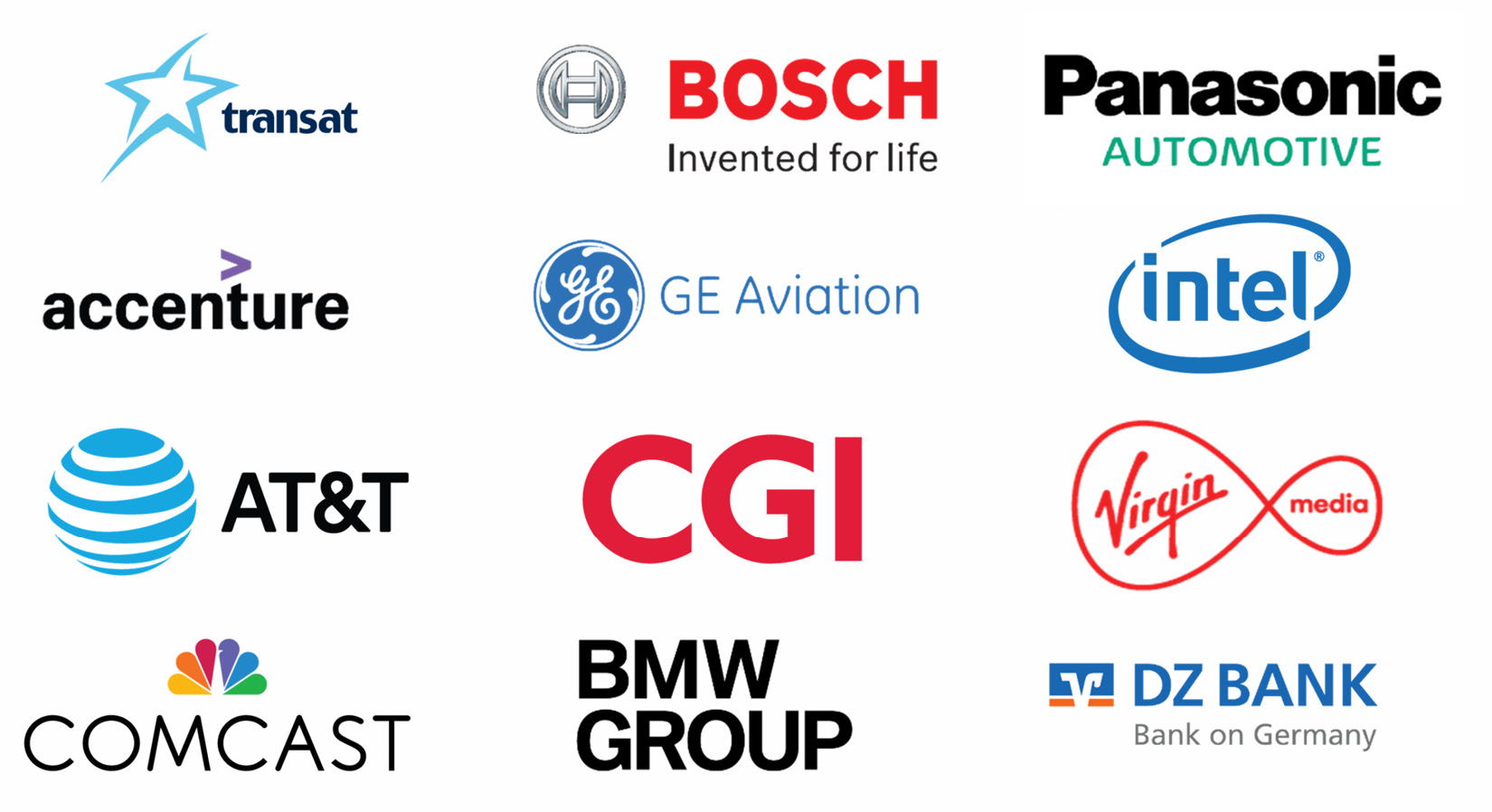
Figure 12.20 – Tasktop customers
More information is available on Tasktop's website: https://www.tasktop.com/.
Apptio/Targetprocess
Targetprocess, acquired by Apptio in February of 2021, is fundamentally a software platform that aid in the adoption and scaling of Agile in all its forms. Specifically, the platform offers a visual platform to help IT organizations adopt and scale Agile across their enterprise. In addition, it is also a comprehensive toolchain integration platform.
In this context, Targetprocess supports scaled Agile approaches such as Disciplined Agile, Large Scale Scrum (LeSS), Nexus, SAFe, Scrum, XP, or a custom-built or hybrid Agile framework to achieve business agility and improve value flows throughout the organization. In addition, Targetprocess supports the implementation of Agile practices at the program, product, and team levels.
Targetprocess supports continuous software deliveries with native integrations to CI/CD and DevOps pipeline tools, such as Jira, Azure DevOps, BitBucket, GitLab, GitHub, Jenkins, and Phabricator. Targetprocess also helps align the activities and goals of product management, ITSM, sales, and marketing functions with integrations to the tools they use, such as MIRO, SalesForce, Zendesk, and ServiceNow.
Forrester Research ranks Targetprocess as a Strong Performer in their Forrester Wave™: Value Stream Management Solutions Report (Q3 2020) and as a Leader in the Gartner 2021 and 2020 Magic Quadrant for Enterprise Agile Planning Tools.
Targetprocess helps align business interests with its implementation of objectives and key results (OKRs), financial controls, and an integrated analytical engine. The support of OKRs helps organizations observe disconnects between business goals and related development efforts. The ability to connect business functions with development is one of Targetprocess's strengths.
Targetprocess supports human resource management within its standardized data model across pipeline activities, enabling planners to factor in resource costs, schedules, and allocations. Targetprocess also provides an extensive list of out-of-the-box metrics, and the metrics are extendable, customizable, and available across the toolchains through its tool integrations.
Targetprocess website: https://www.apptio.com/products/targetprocess/
ZenHub
ZenHub is another tool that is not a VSM platform, but it does provide project management and project data display functions, much like Atlassian's Jira software products. However, ZenHub's approach is different in that their suite of team collaboration and project management tools directly expand the functionality of GitHub's cloud-based version control capabilities.
ZenHub's software products provide a layer of abstraction on top of the GitHub source control management repository, delivering project management, planning, workflow automation, and reporting capabilities. In addition, the ZenHub tools use data that's already available within GitHub to provide visibility, reporting, and automation capabilities across the software development pipeline of activities.
The benefit of ZenHub's approach is that software developers and other stakeholders do not need to maintain records in an external system, such as Jira or Asana's products. Instead, ZenHub's products pull information directly and automatically from GitHub based on its commit records. Thus, while other project management software vendors integrate GitHub into their products, ZenHub's approach extends GitHub directly.
The ZenHub approach reduces manual re-entry of data across multiple disparate tools otherwise required to manage source code and artifacts and plan and manage software development activities. Instead of working across multiple third-party applications, ZenHub users move between tabs within the GitHub UI, working with project data that is already shared and available.
ZenHub supports Sprint planning and estimating by connecting, rolling up, and distributing work item information across epics, stories, features, change requests, bug lists, and technical debt work requirements. Additionally, ZenHub supports VSM requirements, providing visualization and reporting capabilities that show work progress and pipeline efficiencies, and help identify bottlenecks via its cumulative flow charts.
At the time of this writing, ZenHub offers seven tools, as shown in Figure 12.17:
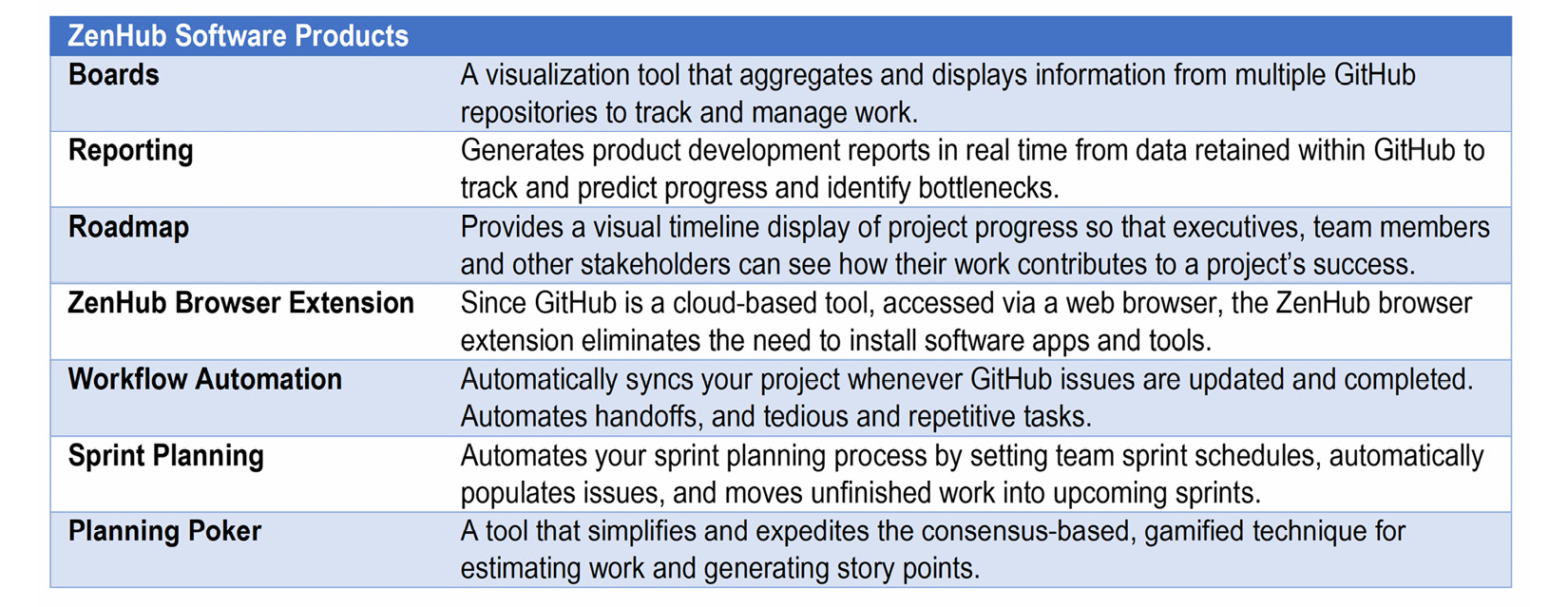
Figure 12.21 – ZenHub software products
ZenHub products are a good fit for those organizations that have already committed to using GitHub for distributed version control and source code management (SCM).
This section ends the introduction to the leading VSM vendors. As you continue to explore this topic on your own, you will find other VSM vendors with solid credentials who were not listed in this book. The primary issue is that some vendors either did not respond to my queries or decided they did not want to participate in the interviews.
Summary
This chapter briefly introduced 19 industry-leading VSM tool vendors and their software offerings. These vendors made our list because one or more IT industry analysts, such as Forrester Research, Gartner, GigaOM, and SD Times, have reviewed and designated the vendors as having relevant offerings in the VSM tool and platform category of software tools. The focus of our reviews is on each vendor's applications and strengths. You also read several use cases highlighting how some of the products were used to improve CI/CD or DevOps pipeline flows.
In the next chapter, you will learn about four leading VSM methodology providers, Disciplined Agile (DA), Scaled-Agile, the Lean Enterprise Institute (LEI), and LeanFITT™. Each provides an approach to implementing VSM practices.
Questions
- True or false: VSM is strictly a tools-based approach to implementing improvements across your CI/CD and DevOps pipelines.
- True or false: VSM is a Lean-oriented approach to making value stream improvements.
- As a quick reminder, what are the common types of waste in Lean production?
- Who were two of the original contributors to the ideas behind applying Lean concepts and value streams within software development?
- Through what aspect or lens did Davenport and Martin view the role IT plays in value stream improvements?
- What are the potential applications for AI and ML in VSM?
- What are the three essential capabilities employed within a CI/CD or DevOps pipeline?
- Fundamentally, what is VSM?
- What are the roots of VSM?
- Trick question: Are the four DORA metrics the only useful metrics in VSM?
Suggested reading
- Martin, James. (1995) The Great Transition. Using the Seven Disciplines of Enterprise Engineering to Align People, Technology, And Strategy. Amacon. New York, New York
- Davenport, Thomas. (1992). Process Innovation: Reengineering Work Through Information Technology. Ernst & Young – Center for Information Technology and Strategy. Harvard Business School Press, Boston, Massachusetts. https://www.researchgate.net/publication/216300521_Process_Innovation_Reengineering_Work_through_Information_Technology
- Kersten, Mik. (July 15, 2020) The Rise of Value Stream Management (VSM). Founder & CEO of Tasktop. Originally published on the Tasktop blog on July 15, 2020. Also posted on LinkedIn. https://www.linkedin.com/pulse/rise-value-stream-management-vsm-mik-kersten/
